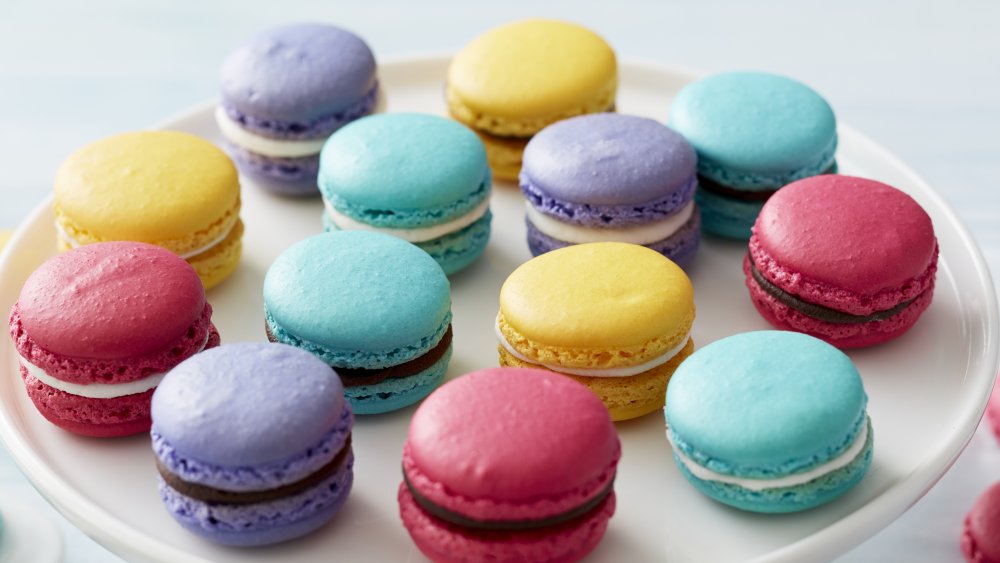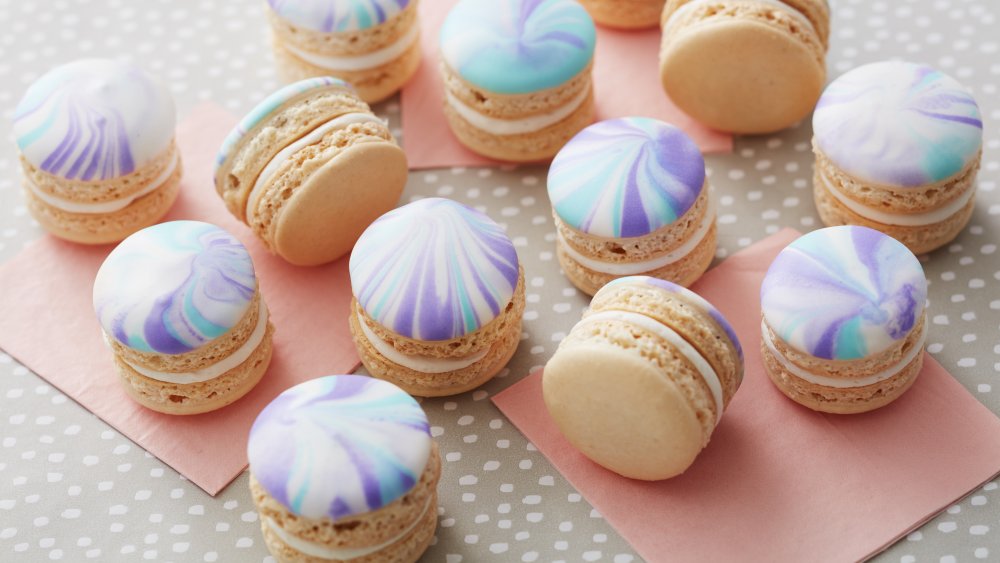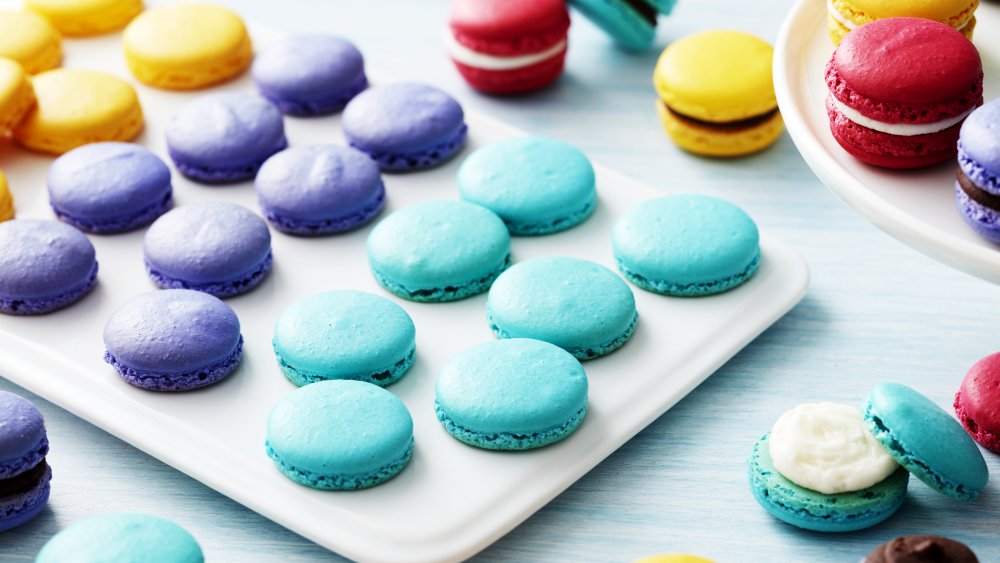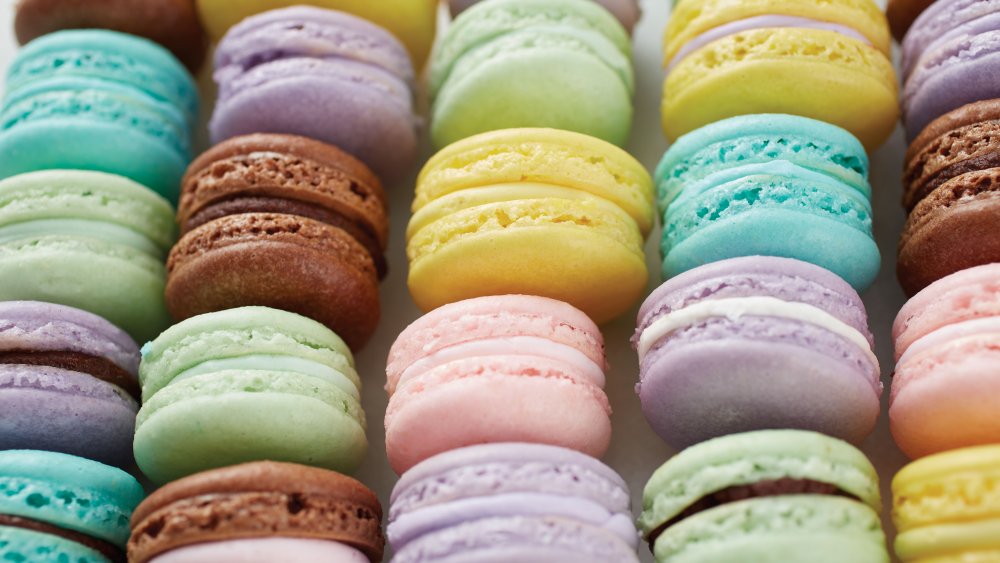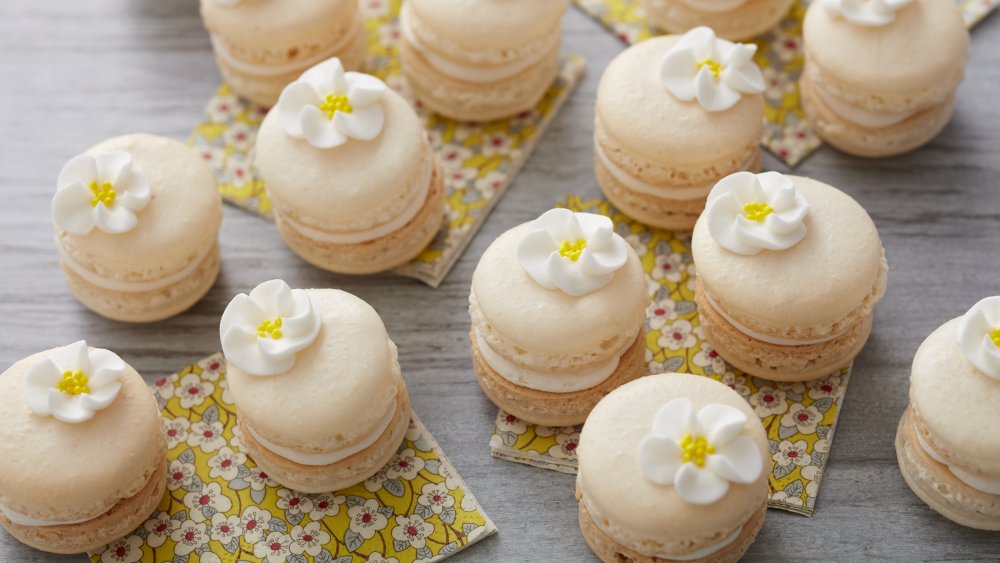Baker Breaks Down The Best Way To Make Macarons
Is there any dessert as ooh-la-la as a macaron? Pronounced mah-ca-ron, this delicate sandwich cookie comes in a rainbow of pastel and vibrant colors that will remind you of doll clothes and Easter eggs. The crispy exterior and chewy interior of this French treat offers a fascinating mouth feel; the thin layer of sweet cookie filling can be fruity, tart or rich, depending on the flavor. Nibble daintily on your macaron, and suddenly you're strolling along the Seine river with a beret perched askew on your head.
If you're craving this très bon dessert and don't plan to be stopping by a Parisian bakery in the near future, no worries — you can make your own with this homemade French macaron recipe. Do be warned that making macarons isn't as easy as, say, whipping up a pan of brownies, or even comparable to something a little more complicated, like a layer cake. You do have to worry about the temperature and consistency of certain ingredients, and you need to allow for periods of rest at stages of the preparation to get bakery-window-worthy results. But you've got this! In an exclusive interview with Mashed, Kathy Krupa, culinary expert, food stylist and macaron queen at baking and cake decorating leader Wilton, offered tips for macaron perfection.
You need to be really careful with the eggs
The airy-yet-crispy consistency of a macaron is due to the meringue batter — of which the eggs are the starring ingredient. And, like all celebrities, they are a little bit fussy; you can't just grab some out of the fridge and crack 'em into a bowl. "Make sure your egg whites are at room temperature and that they are aged," Krupa explained. Aged... does that mean old or expired eggs? Mais non! "To age egg whites, separate the yolk and the whites then store the egg whites in an airtight container in the fridge," she said. "Egg whites should be brought back up to room temperature before use in the recipe so they will whip up better."
Once you have your eggs eggs-actly where you want them, it's time to whip up the meringue. Which is also a balancing act. "Whip the eggs to stiff peaks, but don't over-whip the meringue, which can make the macarons too tall or too hollow. It should look glossy and smooth — visually similar to shaving cream," Krupa said.
When the meringue is the right consistency, add your color right then and there if you're only using one color, Krupa said. "This helps prevent over mixing in the end," she explained.
How not to strike out with the batter
If getting the eggs right sounds like a delicate process, note that there's also a lot of room for error when you're transforming the meringue into the batter that you'll be baking with. To prevent striking out with the batter, Krupa recommends folding in the dry ingredients in three phases. Then do a check to make sure your batter is the right thickness and wetness. "If your batter doesn't run slowly off your spatula — to look like lava — use the spatula to press the batter against the side of the bowl to help loosen the batter slightly," Krupa said. This process, she said, is called "macaronage."
You'll know when your batter is ready, Krupa said, "when you can create a figure 8 pattern with the batter as it falls off the spatula. It should slowly be absorbed back in the batter in about 10 seconds." A batter that isn't wet enough will produce macarons without their iconic "feet," she warned.
Pipe, then bake
If you're used to making cakes, piping has typically be something you've done after you've baked; the proverbial "icing on the cake" requires a cake, after all, to have been baked. But if you haven't figured it out yet, macarons are not cakes. They make their own rules. And one of those rules is to pipe first, Krupa said.
"I like to use tip 2A to pipe macarons on parchment or a silicone liner. Use a template for even circles," Krupa said. Once you've done the piping, hold off before you fire up the oven. Both you and the macarons need a little break, first. "Macarons should rest 25-30 minutes after piping and before baking," Krupa warned. "This will help them develop a skin-like texture on the tops. You should be able to run your finger across the tops smoothly."
Once the macarons are ready to bake, leave the paper pattern underneath the parchment before putting in the oven. "Make sure the macarons are done cooking by touching the top of cookies. It should be firm and the cookie shouldn't move around," Krupa said. If the macaron tops are cracked, the temperature was too high.
Decorate, then fill, for optimal results
When the shells (the top and bottom parts of the sandwich cookie) are done, this is when you get to have some fun and add flair by drawing flowers, swirls, letters — your creativity is the only limit! But as is the case with all stages of the macaron making process, make sure you do things in the right order. "If you plan on decorating shells with edible paint or pens, it will be easier to do this before filling the macarons," Krupa said.
After that, she said, fill with buttercream, ganache or jam. You'll probably look at these gorgeous little cookies — that you worked SO hard on, avoiding so many landmines of too-cold eggs or too-wet batter — and want to gobble them up on the spot.
But... you can't do that, Krupa said. "Let them set for a day!" she said. A day?! What??
We know, we know... it's hard to have such treats laying untouched in your kitchen. But Krupa promises it will be worth the wait: "Giving it time to set improves the overall flavor and texture," she explained.
